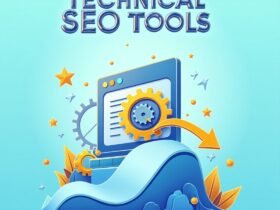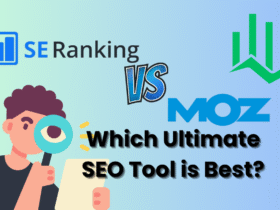SEO (Search Engine Optimization) is the process of improving a website’s visibility on search engines. The goal of SEO is to increase organic (non-paid) traffic to a website by making it more relevant and authoritative in the eyes of search engines. When your site ranks higher in search results for specific keywords, it becomes more likely that users will click on your link and visit your site.Learn how to optimize your site by exploring the “four types of SEO”.
Why is SEO Important?
- Increased Visibility: Higher rankings mean more people will see your website.
- Organic Traffic: SEO helps you attract visitors without paying for ads.
- Credibility and Trust: Websites that rank high are often perceived as more trustworthy.
- Better User Experience: SEO is needed for improving site speed, mobile-friendliness, and content quality, which benefits users.
- Cost-Effective Marketing: Unlike paid ads, organic traffic from SEO is free once you’ve optimized your site.
How Does SEO Work?
Search engines use bots (also called crawlers or spiders) to scan and index websites. They analyze factors like:
- Relevance: Does your content match what users are searching for?
- Authority: Is your site trusted and linked to by other reputable sites?
- User Experience: Is your site fast, mobile-friendly, and easy to navigate?
Based on these factors, search engines rank websites in their results pages (SERPs – Search Engine Results Pages). SEO helps you optimize your site to meet these criteria.
Key Components of SEO
SEO is a multifaceted strategy that requires a balanced approach, combining technical aspects with high-quality content, effective link-building, and a focus on user experience. By mastering these components, businesses can significantly improve their search engine rankings, attract more organic traffic, and ultimately drive higher conversions. Whether you’re focusing on local SEO or aiming for global reach, an effective SEO strategy is essential for online success.
- On-Page SEO: Optimizing individual pages on your site (e.g., content, keywords, meta tags, and internal links).
- Off-Page SEO: Building your site’s authority through backlinks, social media, and online mentions.
- Technical SEO: Improving the backend of your site (e.g., site speed, mobile-friendliness, and crawlability).
- Local SEO: Optimizing your site to attract local customers (e.g., Google My Business, local keywords).
Search Engine Optimization (SEO) is a powerful tool to help your website rank higher on search engines like Google. But did you know there are different types of SEO? Each type focuses on a specific area of optimization. Understanding these types can help you create a well-rounded strategy to improve your site’s visibility and attract more visitors.
In this guide, we’ll explore the four types of SEO: On-Page SEO, Off-page SEO, Technical SEO, and Local SEO. Which is considered as the most important SEOs. We’ll break down what each type involves and provide practical tips to optimize your site effectively. Let’s dive in!
1. On-Page SEO: Optimizing Your Content and Pages
On-page SEO focuses on optimizing the content and structure of your website’s pages. It’s about making your site more relevant and user-friendly for both search engines and visitors. Here’s how you can master on-page SEO:
Keyword Research and Placement
– Start by finding the right keywords. These are the terms people type into search engines when looking for information.
– Use tools like Google Keyword Planner, Ahrefs, or SEMrush to discover keywords that match your content.
– Place your keywords naturally in your content. Include them in:
– Titles
– Headings (H1, H2, H3)
– Meta descriptions
– URL slugs
– The first 100 words of your content
– Avoid keyword stuffing. Overusing keywords can hurt your rankings.
High-Quality Content
– Create content that answers your audience’s questions. Make it informative, engaging, and easy to read.
– Use short paragraphs, bullet points, and subheadings to break up text.
– Add images, videos, or infographics to make your content more appealing.
– Update your content regularly to keep it fresh and relevant.
Meta Tags
– Write compelling meta titles and descriptions. These are the snippets that appear in search results.
– Keep your title under 60 characters and your description under 160 characters.
– Include your primary keyword in both the title and description.
Internal Linking
– Link to other pages on your site. This helps search engines understand your site’s structure and keeps visitors engaged.
– Use descriptive anchor text (the clickable text in a link) to give context about the linked page.
Mobile-Friendly Design
– Ensure your site looks great on all devices, especially mobile phones. Most users browse the web on their phones, so a mobile-friendly site is a must.
User Experience (UX)
– A good user experience is crucial for on-page SEO. Make sure your site is easy to navigate.
– Use clear calls-to-action (CTAs) to guide users on what to do next.
– Ensure your site is accessible to all users, including those with disabilities.
2. Off-Page SEO: Building Your Site’s Authority
Off-page SEO is all about building your site’s reputation and authority. It involves activities outside your website that help improve its ranking. The most important part of off-page SEO is link building.
Backlinks
– Backlinks are links from other websites to your site. They act as votes of confidence, telling search engines your content is valuable.
– Focus on getting backlinks from high-quality, authoritative sites in your niche.
– You can earn backlinks by:
– Creating shareable content like blogs, infographics, or videos.
– Guest posting on reputable websites.
– Building relationships with influencers and industry leaders.
Social Media Engagement
– While social media links don’t directly impact rankings, they can drive traffic and increase visibility.
– Share your content on platforms like Facebook, Twitter, LinkedIn, and Instagram.
– Engage with your audience by responding to comments and messages.
Online Reviews and Mentions
– Positive reviews on platforms like Google My Business, Yelp, or Trustpilot can boost your credibility.
– Encourage satisfied customers to leave reviews.
– Monitor your online reputation and address negative feedback promptly.
Brand Mentions
– Even if a site doesn’t link to you, simply mentioning your brand can help build awareness.
– Use tools like Google Alerts to track mentions of your brand online.
Forum Participation
– Participate in forums and online communities related to your industry.
– Provide valuable insights and link back to your site when relevant.
3. Technical SEO: Improving Your Site’s Performance
Technical SEO focuses on the backend of your website. It ensures your site is easy to crawl and index by search engines. A technically sound site provides a better user experience and ranks higher.
Site Speed
– A slow website frustrates users and hurts your rankings.
– Use tools like Google PageSpeed Insights to check your site’s speed.
– Optimize images, enable browser caching, and minimize code to improve loading times.
Mobile Optimization
– Google uses mobile-first indexing, meaning it primarily uses the mobile version of your site for ranking.
– Test your site’s mobile-friendliness with Google’s Mobile-Friendly Test.
– Use responsive design to ensure your site adapts to different screen sizes.
Secure Website (HTTPS)
– Secure your site with HTTPS. This encrypts data between your site and its visitors, making it safer.
– Google gives a ranking boost to secure sites.
XML Sitemap
– An XML sitemap is a file that lists all the pages on your site. It helps search engines crawl and index your content.
– Submit your sitemap to Google Search Console.
Robots.txt
– The robots.txt file tells search engines which pages to crawl and which to ignore.
– Ensure your robots.txt file is properly configured to avoid blocking important pages.
Structured Data
– Structured data (or schema markup) helps search engines understand your content better.
– Use schema markup for things like reviews, recipes, events, and FAQs.
– This can lead to rich snippets in search results, which improve click-through rates.
Fix Broken Links
– Broken links create a poor user experience and can harm your rankings.
– Use tools like Screaming Frog or Ahrefs to find and fix broken links.
Canonical Tags
– Use canonical tags to avoid duplicate content issues. These tags tell search engines which version of a page is the original.
Crawlability
– Ensure search engines can easily crawl your site. Avoid using Flash or JavaScript for important content, as search engines may not be able to read it.
4. Local SEO: Attracting Nearby Customers
Local SEO helps your business appear in local search results. It’s especially important for businesses with physical locations or those serving specific areas.
Google My Business (GMB)
– Claim and optimize your Google My Business profile.
– Add accurate information like your business name, address, phone number, and website.
– Upload high-quality photos of your business.
– Encourage customers to leave reviews on your GMB profile.
Local Keywords
– Use location-based keywords in your content. For example, “best pizza in New York” or “plumber in Los Angeles.”
– Include your city or region in your meta tags, headings, and content.
NAP Consistency
– NAP stands for Name, Address, and Phone number. Ensure this information is consistent across your website, GMB profile, and online directories.
Local Citations
– List your business in local directories like Yelp, Yellow Pages, and TripAdvisor.
– Consistent citations help build trust with search engines.
Localized Content
– Create content that appeals to your local audience. For example, write blog posts about local events or news.
– Use local landmarks or neighborhoods in your content to make it more relevant.
Customer Reviews
– Positive reviews from local customers can boost your local rankings.
– Respond to reviews, both positive and negative, to show you value customer feedback.
Local Link Building
– Get backlinks from local websites, such as local news outlets, blogs, or community organizations.
– Sponsor local events or charities to gain visibility and backlinks.
How to Combine the Four Types of SEO for Maximum Impact
To get the best results, you need to use all the four types of SEO together. Here’s how they work in harmony:
1. On-page SEO ensures your content is optimized for both users and search engines.
2. Off-page SEO builds your site’s authority and trustworthiness.
3. Technical SEO makes your site fast, secure, and easy to crawl.
4. Local SEO helps you attract nearby customers and stand out in local searches.
By combining these strategies, you’ll create a strong foundation for your site’s success.
To learn more details about the four types of SEO mentioned above check out our latest post about the “4 pillar of SEO” ➡ https://techsoftdigi.com/the-4-pillars-of-seo-a-simple-guide-to-boosting/
Tips for Ongoing SEO Success
SEO is not a one-time task. It requires ongoing effort and adjustments. Here are some tips to stay on top of your SEO game:
– Monitor Your Performance: Use tools like Google Analytics and Google Search Console to track your rankings, traffic, and user behavior.
– Stay Updated: SEO trends and algorithms change frequently. Follow reputable SEO blogs and forums to stay informed.
– Experiment and Adapt: Test different strategies to see what works best for your site. Be willing to adapt based on the results.
– Focus on User Experience: Always prioritize your users. A site that’s easy to navigate and provides value will naturally rank higher.
– Regular Audits: Conduct regular SEO audits to identify and fix issues. Tools like Screaming Frog, Ahrefs, and SEMrush can help with this.
– Content Calendar: Plan your content in advance. A content calendar helps you stay consistent and cover a wide range of topics.
– Competitor Analysis: Keep an eye on your competitors. Analyze their SEO strategies and learn from their successes and mistakes.
Common SEO Mistakes to Avoid
Even with the best intentions, it’s easy to make mistakes in SEO. Here are some common pitfalls to watch out for:
1. Ignoring Mobile Optimization: Ignoring mobile optimization is a big mistake, especially since most people now browse the web on their phones. If your website isn’t mobile-friendly, it can frustrate users who struggle to navigate or read your content on smaller screens.
2. Overloading with Keywords: Keyword stuffing can lead to penalties from search engines. It is a risky practice that can backfire. While it might seem like a quick way to boost your rankings, search engines like Google are smart enough to recognize when keywords are being used unnaturally or excessively. This can lead to penalties, causing your site to drop in rankings or even get removed from search results altogether.
3. Neglecting Technical SEO: A beautiful site won’t rank well if it’s slow or hard to crawl. Technical SEO ensures that search engines can easily access, understand, and index your site.
4. Not Tracking Progress: Without analytics, you won’t know what’s working and what’s not. It is like driving without a map—you might be moving, but you have no idea if you’re headed in the right direction.
5. Focusing Only on Rankings: Focusing only on rankings isn’t enough. While it’s great to see your website climb to the top of search results, what really matters is what happens after users click on your site. Traffic, engagement, and conversions are just as important as rankings because they show that your site is not only visible but also valuable to your audience.
6. Ignoring Local SEO: Even if you’re a global brand, local SEO can help you connect with nearby customers.
The Future of SEO
SEO is constantly evolving. Here are some trends to keep an eye on:
1. Voice Search Optimization: With the rise of smart speakers, optimizing for voice search is becoming crucial.
2. AI and Machine Learning: Search engines are using AI to deliver more personalized results.
3. Video Content: Video is becoming a dominant form of content. Platforms like YouTube are search engines too.
4. E-A-T (Expertise, Authority, Trustworthiness): Google prioritizes content from credible sources.
5. Core Web Vitals: Google’s focus on user experience means factors like loading speed and interactivity will play a bigger role.
Conclusion
SEO is a multifaceted strategy that involves on-page, off-page, technical, and local optimization. By using these four types of SEO, you can make your site easier to find, bring in more visitors, and reach your online goals.
Remember, SEO is a long-term investment. It takes time and effort, but the rewards are worth it. Start optimizing your site today, and watch it climb the search engine rankings!
By following this guide, you’ll be well on your way to mastering SEO and driving more traffic to your site. Happy optimizing!
1. What Are the Four Types of SEO?
The four types of SEO are:
On-Page SEO – Optimizing content, meta tags, and internal links for search engines.
Off-Page SEO – Building backlinks and improving external signals to boost authority.
Technical SEO – Enhancing website speed, structure, and mobile-friendliness.
Local SEO – Optimizing for local searches and Google My Business listings
2. Why Is It Important to Master All Four Types of SEO?
Mastering all four SEO types ensures your website is optimized from every angle—improving search visibility, driving traffic, and enhancing the user experience.
3. How Does On-Page SEO Differ from Off-Page SEO?
On-page SEO focuses on optimizing elements within your website (e.g., content, headings), while off-page SEO involves external strategies like link building and social signals to boost credibility.
4. What Role Does Technical SEO Play in Website Optimization?
Technical SEO improves how search engines crawl and index your site by optimizing aspects like site speed, structured data, and mobile usability, which enhances your search ranking.
5. How Can I Improve My Local SEO?
To improve local SEO, focus on Google My Business optimization, gather positive reviews, and ensure your NAP (Name, Address, Phone Number) information is consistent across directories.






2 Comments